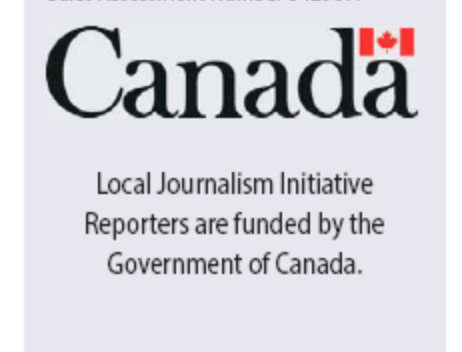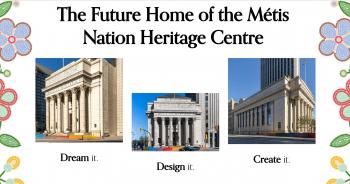Summary
Local Journalism Initiative Reporter
Windspeaker.com
The purchase of the former Bank of Montreal building in downtown Winnipeg by the Manitoba Metis Federation(MMF) is a solid step forward in the fulfillment of a goal set nearly two decades ago by the Métis Nation to create a museum and heritage centre.
“I was given the green light to move on it close to 20 years now,” said MMF President David Chartrand, who also serves as vice president for the Métis Nation Council. That direction came from the other four Métis Nation governments in British Columbia, Alberta, Saskatchewan and Ontario.
“This is where the Nation really starts, right in the Red River. The heart of the Nation really evolves from here. It was given to me to pursue it vigorously and go after it,” said Chartrand.
All the funding and all the work for the heritage centre has come from the MMF, he says, and the MMF has not asked for financial support from any of the other Métis Nation governments.
“I would be shocked if they said, ‘I want a say in it now.’ I’d be quite shocked if they come forward and I’d be quite dismayed if somebody tried to do that now,” he said.
The MMF purchased the 107-year-old Bank of Montreal building in May for a “mutually agreed upon” price that Chartrand won’t divulge to the general public until he has told membership in assembly. That assembly, which was to take place in September, has been postponed to March, because of COVID-19.
“We believe we got a very good deal on it. I think the intention by the Bank of Montreal was to find a good owner that would keep the ideology of the historical premises as being important,” said Chartrand.
To that end, the MMF is holding an open competition for a design for the heritage centre that takes into consideration the building’s interior and exterior architectural qualities, including concrete pillars and a gold-plated ceiling. There are two areas to work with, the main floor which is 8,200-square-feet and the mezzanine at 5,505-square-feet.
Chartrand expects submissions will come from engineers, architects and artisans. While the competition is open to all Canadians, he says, if two designs are similar, one presented by a Métis person and one by a non- Métis, the Métis submission will get the nod.
“But if (a submission) has a complete unique design and it doesn’t happen to be coming from the Métis, but really depicts the true message we’re trying to give out in our design, then we’re not going to be saying it’s only Métis artists or artisans or engineers. The museum is really an invitational concept,” said Chartrand.
He also points out that the name of the centre will be based on the story and message behind the winning design. That story will be told to the Elders and the assembly and a name for the centre chosen.
The winning design, to be judged by a jury, will receive $10,000. Second place and third place will receive $5,000 and $2,500, respectively, and five runners-up will each receive $1,000. Submission deadline is Sept. 28, with the winner to be announced Oct. 22.
There is also a youth component to the competition, which includes youth designing a single exhibit, the centre’s logo or the mascot. Ten prizes will be awarded, ranging from television game systems to a fishing rod and reel.
Chartrand is hopeful that once the design is chosen, it will take less than a year until the doors to the centre are opened. It is anticipated it will cost $6 million to $10 million for the necessary work to be undertaken, which will include climate control exhibition areas to allow for the proper care of repatriated items.
While Chartrand is pleased with the purchase of the Bank of Montreal building, that location was not his first choice. He had initiated talks with the City of Winnipeg to be included in The Forks.
“The Forks frustrated us. They should have figured out how in the hell they get the Métis museum there, one of the founders of Manitoba, into our story in the Forks. Instead of including or wanting or trying to find means and ways it was, obvious to me, basically not a very strong priority for them,” said Chartrand.
Tourism Winnipeg promotes The Forks, located where the Red and Assiniboine rivers meet in downtown Winnipeg, as “a meeting place for over 6,000 years. Early Aboriginal peoples traded at The Forks, followed by European fur traders, Métis buffalo hunters, Scottish settlers, riverboat workers, railway pioneers and tens of thousands of immigrants.”
However, the old Bank of Montreal building, at the south-east corner of Portage and Main, is well-located for Chartrand’s aim to promote it as one of a number of museums in the area, which includes the Canadian Human Rights Museum and St. Boniface Museum, that tourists can visit.
“This will be the first Métis museum of the Métis Nation. One that will truly pride itself in the true story of our history,” he said.
That building will also be utilized for office space by the MMF. With more than 800 employees and 200 to 300 more to be hired, Chartrand says the old office is “running out of space.”
He adds that an offer to purchase another downtown building —five times larger than the Bank of Montreal—from a private owner has been accepted.
“Its intended use is office space for us and investment toward economic growth by leasing out and formulating our economic footprint when it comes to real estate,” he said, noting he wasn’t sure when the formal announcement of the unnamed-building purchase would be made.
The MMF owns three buildings in Winnipeg offering more than 100,000-square feet, all rented and filled. The MMF owns buildings across the province, said Chartrand, “probably 15 major giant buildings” along with smaller office buildings.
Design competition information can be found at https://www.journeyintheheartofthehomeland.com/home
Local Journalism Initiative Reporters are supported by a financial contribution made by the Government of Canada.


